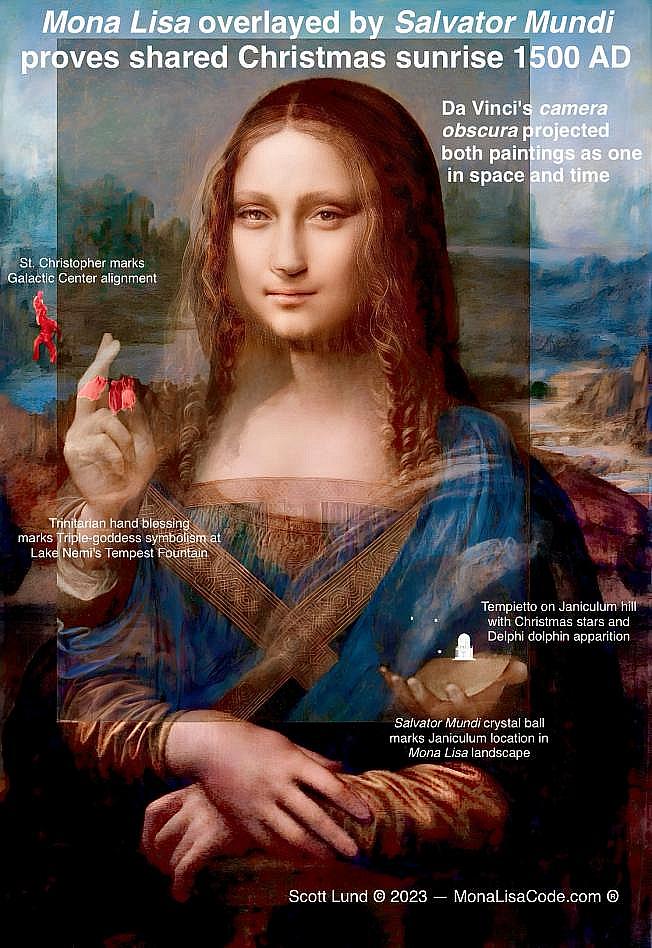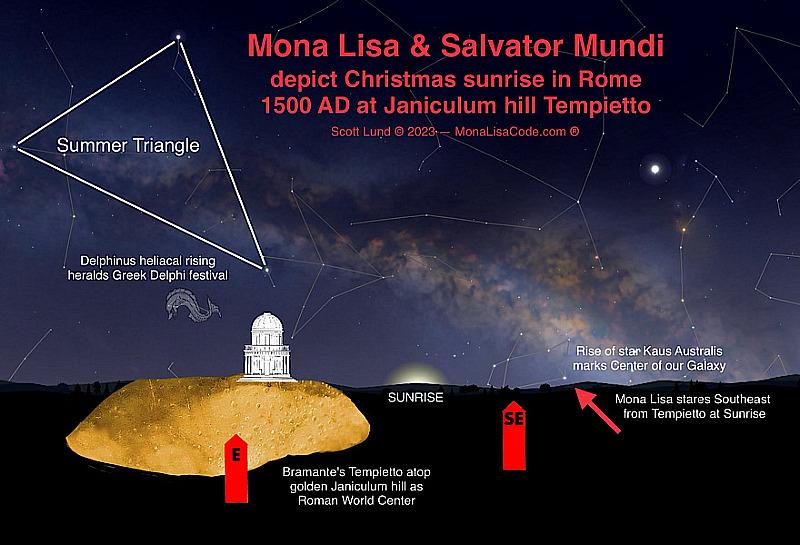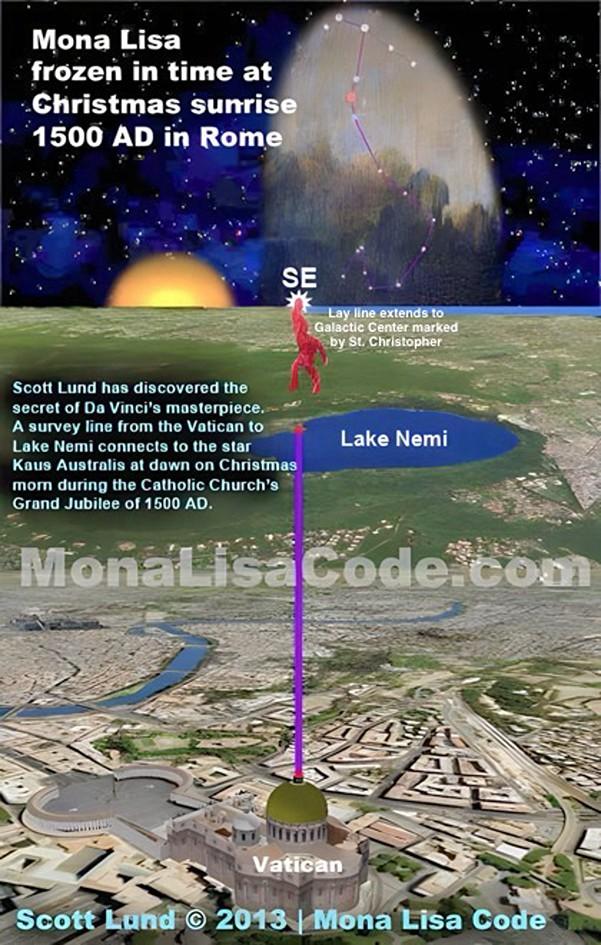
Da Vinci’s camera obscura projected both paintings as one single vision in time and space
Three lone stars seen within Salvator Mundi’s mysterious crystal ball ends serious dispute—the painter was indeed Leonardo da Vinci himself. Visionary historian Scott Lund has identified the stars as the prominent Summer Triangle asterism that appeared Christmas morning above Bramante’s Tempietto on Rome’s Janiculum hill in 1500 AD.

Ten years ago, Scott Lund determined that a ley line ran through the Mona Lisa’s landscape—extending from the Vatican directly 29.5 km Southeast to the main cult site of the goddess Diana at Lake Nemi. As a climax to the Vatican’s Grand Jubilee year of 1500, Da Vinci envisioned Mona Lisa on the steps of the Tempietto, face awash in the light of dawn, as she gazed at the line’s momentary projection beyond the horizon into the exact center of our Milky Way galaxy. At that moment, she was also looking in the direction of Delphi, Greece, 935 km ahead.

But Lund never expected that Salvator Mundi might provide independent corroboration for that very same sunrise. When he applied a simple 50/50 opacity overlay of Salvator Mundi onto Mona Lisa, Lund was stunned. By focusing the facial features of both paintings together, a breathtaking Man-goddess appeared in glowing 3D perspective!
The overlay also showed Salvator Mundi’s crystal ball laying directly over where the Janiculum hill would be situated in the Mona Lisa landscape. Suddenly, the three stars seen over the resplendent hill made perfect sense to Lund. It was never a crystal ball, but rather a telescopic view looking East at the Janiculum, with the city of Rome hidden on the other side.
Very close to the lowest star of the Summer Triangle on that Christmas morning, the heliacal rising of Delphius was seen—a tiny constellation that famously heralded the games at Delphi in antiquity. Yet another allusion to Delphi may be perceived as a ghostly dolphin image hovering over the ‘crystal ball’ in overlay.
The right hand of Salvator Mundi is seen in a classic Trinitarian blessing gesture. In overlay, the hand envelops a rocky outcropping of three witches in the form of owls at the Tempest Fountain, just above Lake Nemi. The Trinity theme is reinforced by coins from the lake cult site featuring three Dianic goddesses side-by-side.
More amazing still, it appears to Lund that Da Vinci used a camera obscura to scale Salvator Mundi down to fit over the smaller torso proportions of the Mona Lisa. Salvator Mundi was painted in 1502 AD, around the same time that his treatise on the pinhole camera was made public. It was essentially an invention that allowed artists to simply trace onto their canvas from another projected image. Lund also believes Da Vinci’s Vitruvian Man provided a template for the sacred proportions that came together so perfectly.
“Certainly Salvator Mundi was painted with the intention of projecting it onto the Mona Lisa with a camera obscura,“ says Lund. “Practically no one has ever seen the beauty of the Mona Lisa in the ultimate illuminated and glowing way that Da Vinci really created her.”
Known for its yellow sand, the Janiculum became the fabled “golden mountain” of Rome. The Mona Lisa, Salvator Mundi, and the Tempietto were entirely about the assertion of Spanish King Ferdinand and Queen Isabella as the champions of Christendom and conquerors of the just discovered New World. Since 1492, the Vatican was headed by the infamous Spanish Borgia pope Alexander VI, who favored an old myth that Biblical Noah came to Rome by boat, changed his name to that of the Roman Sun- and War-god Janus, and founded a Golden Age in Italy ruled from his glorious city atop the Janiculum hill. The myth was expanded and promulgated by Dominican friar and antiquities forger Annius of Viterbo, named Master of the pope’s palace in that city as a reward for his work. Da Vinci was evidently responsible, along with Bramante, for convincingly elaborating the myth, especially through evidence of sacred geometry and astronomical metaphor. Lund believes Pope Alexander VI and the Spanish monarchs desired a symbolic conflation of the Roman god with Noah in order to establish on the Janiculum a Roman oracular counterpart to Greek Delphi. And the divine genius of Da Vinci made it all astoundingly convincing.
Salvator Mundi was sold in 2017 to Saudi Arabian crown prince Mohammed bin Salman for $450 million, making it the most expensive painting ever sold. “Doubts about the authenticity of Salvator Mundi can now be dispelled with this new archeo-astronomic evidence,” says Lund. “It is fantastic that the world’s most famous painting and the world’s most expensive painting were meant to be projected together into a single vision, bringing space and time together at the same exact point.”
SURPRISE INFORMATION:
The Tempietto’s Foundation Stone, buried and accidentally uncovered many years later, was dated 1502 and dedicated to Ferdinand and Isabella.
The marble slab has a wide-to-high ratio of 68.807339%
And theMona Lisais an incredibly identical 68.831168% !!!!!!!
“It is known the Mona Lisa was initially a bigger painting sawed off on its sides, and it may be presumed that its width was reduced to conform to the proportions of the Foundation Stone,” says Lund. The same ratio shared between the Mona Lisa and the Foundation Stone also matches the Tempietto’s width and height. The Mona Lisa and the Tempietto were obvious sister projects created together by close friends Da Vinci and Bramante.
“May the notion that Mona Lisa was the mere portrait of a middle-class silk merchant’s wife in Florence be consigned to banal fallacies of the past. The union of Mona Lisa and Salvator Mundi, under the stars of Christmas, is a gift of marvelous vision from Da Vinci’s wondrous mind.”
— Scott Lund, December 2023
[The multiple discoveries of Scott Lund are named The Mona Lisa Code ®️. They constitute a well-recognized corpus of factual corroborating evidence beyond reasonable doubt.]


